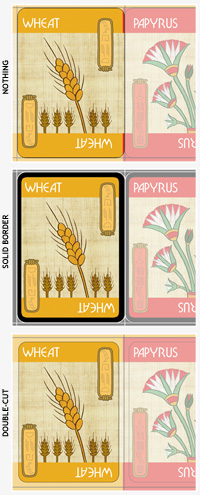
For the better part of the last year, I’ve been pouring much of my creative energy into work for Minion Games. Six games later, I’m finally done for the year. While I can't say I’ll exactly miss the overnight deadlines, constant revisions, and counting pixels, I find myself a little lost without the nagging Minion at my side. I’ve been on board with this board game company since its inception in late 2009, and there was always a game to work on, a convention to make. Now that there isn’t, the ability to breathe is welcome but alien, too.
Of course, the upshot of this new free time is I can actually spare a moment to share my toils with you. Welcome to Minion Monday!
Nile was one of our first games — and our earliest success. But our original printer, an outfit from China, provided a product with chitzy cards, fragile boxes, and, in the worst cases, thoroughly damp product. With our 2011 wave of games, we switched to Ludo Fact, a German printer. The price involved was considerably more, but the end result was worth the investment. Nile DeLuxor takes advantage of this better production and includes the all new Monuments expansion and additional crop types to support more players.
Since it’s a re-release of an old game, most of the work was repurposing old art to fit the new bigger box (and boy it’s great to hold!) and expanding the manual with new rules and much-needed graphical examples. But working on it reminded me of an important lesson we learned the first time around.
 When cards are produced, they are initially printed out on a huge sheet. This over-sized poster is then cut into the familiar round-cornered rectangles we know and love. By nature of this process, the printed artwork may not perfectly line up with the dies, the metal blades that cut the shapes. The result is the top image on the right. See how the Papyrus’ red is visible on the Wheat card?
When cards are produced, they are initially printed out on a huge sheet. This over-sized poster is then cut into the familiar round-cornered rectangles we know and love. By nature of this process, the printed artwork may not perfectly line up with the dies, the metal blades that cut the shapes. The result is the top image on the right. See how the Papyrus’ red is visible on the Wheat card?There are two ways to get around this. What you’ll see most of the time is a solid-colored border all the way around the card, like in Magic: The Gathering and many other collectable card games. When the graphic gets shifted, it’s not nearly as noticeable.
The option we opted for was the double-cut method. Extra art, or “bleed,” extends from all sides. Instead of a single cut separating cards, an additional cut is made. The excess is discarded, and you have a card that will appear correct no matter which way the art shifts with no visible border. Looks nice, right?
Now here’s where the “lesson” comes in. It costs much, much more to cut cards this way! We did decide to keep the double-cut look for Nile DeLuxor, but it’s an expense any of you aspiring game-makers out there should keep in mind.
As for game itself, I could go into detail about its rules, strategy, and agricultural antics, but the fellow at Drake's Forge does a much more entertaining job of it. He’s right. If Nile is remotely historically accurate, it positively sucks to be a farmer in ancient Egypt.
If you’re interested in purchasing the game, please do so from our website, Minion Games. More of your hard-earned money goes to the hard-working people who make these games!


Very nice blog--I am now following. And thanks for all the great work on Kingdom of Solomon and the other titles. You rock!
ReplyDeleteThanks for dropping by Philip! I appreciate your kind words and your following. You should enjoy the latest entry! ;)
ReplyDelete